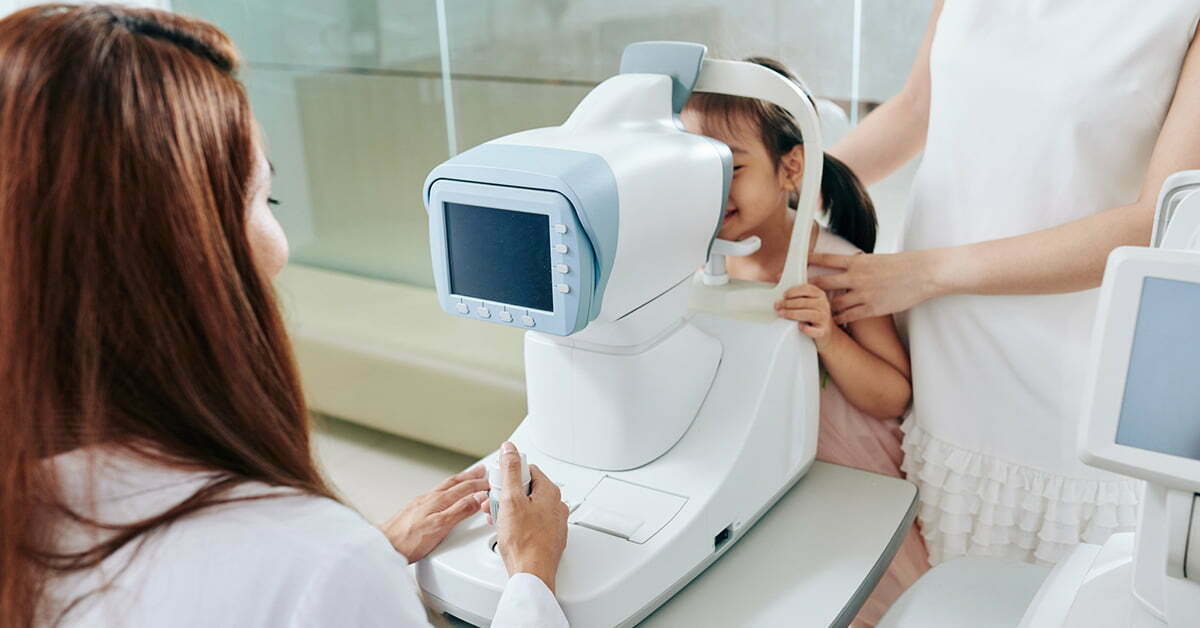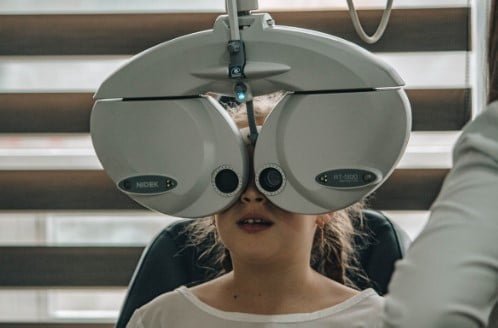
For children, visiting the optometrist can be an intimidating experience, especially if it’s their first time. Helping them understand what an eye exam is and why they need one can ease their fears about an upcoming visit. It can benefit parents and caregivers to know what to expect from a pediatric eye exam so that they can explain these details to a child. Regular eye exams should happen at scheduled intervals for children to ensure that their vision is developing properly. Here’s some more detail about what’s involved in a pediatric eye exam.
Why Do Children Need an Eye Exam?

A common misconception about a child’s eye health is that they don’t need an eye exam until they begin school, as this is when they typically start learning to read. However, by getting a pediatric eye exam earlier, usually around the age of three, eye health issues can be detected before a child starts school. This allows the child’s doctor to monitor any concerns and treat problems as soon as possible. Good vision is key to making the most of any learning environment, so scheduling a pediatric eye exam ensures you give your child the tools they need to succeed.
How Do You Prepare a Child for an Eye Exam?
To prepare your child for an upcoming eye exam, you should talk to them about what to expect. An optometrist’s office is typically full of unusual tools and machines that your child won’t be familiar with. You can explain to your child that the machines and devices they are going to encounter will help the doctor look at their eyes and make sure that they’re healthy. You can also find out what tests the doctor may perform and what they entail, so you can discuss this with your child. Be honest with your child about what the doctor will do.
For example, if they’re going to put drops in your child’s eyes, tell this to your child and let them know that it won’t hurt, but the drops may feel uncomfortable at first. You can also talk about what types of objects or shapes the doctor may have them look at and explain that they need to help the doctor by telling them what they see. Let your child know that the eye doctor is there to help and that it’s a safe place. This type of appointment should always include the parent so that the child feels comfortable.
What Does a Pediatric Eye Exam Check For?
At a pediatric eye care clinic, an optometrist performs an eye exam mainly to ensure the health and development of a child’s eyes. They can use a pediatric eye exam to detect some common problems, such as amblyopia. This is also referred to as lazy eye, where one eye develops normally, but the other doesn’t. The cause of amblyopia isn’t always known, but there are some effective treatments that can help correct the problem when detected early. Discuss treatment options with your child’s optometrist to ensure they get the right care.
An optometrist will also check a child’s eyes for infections, cataracts, inflammation, and other signs of poor eyesight. Conjunctivitis, also called pink eye, is another common problem found in children’s eyes. It’s very contagious, and although it doesn’t usually cause long-term problems, it can if left untreated. Sometimes, conjunctivitis results from allergies. This type of pink eye isn’t contagious but can lead to eye irritation that causes a child to constantly rub their eyes, possibly causing more serious problems. Getting a vision screening for your child can detect any of these issues if they exist.
What Is Involved in a Pediatric Eye Exam?
Every optometrist has their own personal way of conducting a pediatric eye exam. Children are unique, and therefore, each one needs special care. You can meet with your child’s optometrist before the exam to ensure their methods align with how you want your child to be treated. It’s important to understand that the doctor will need you to answer questions about your child that relate to their vision and habits. Some questions you may be asked include the following:
- Does your child seem to squint when looking at objects close up or far away?
- Have you noticed your child rubbing their eyes?
- Are headaches a common complaint with your child?
- Does your child have any developmental delays or a history of surgeries?
Once the doctor understands your child’s history, they’ll perform a series of tests. With these tests, they’ll observe eye movements using tools like lights and charts. Some of the most common things a doctor will be testing for include the following:
- Nearsightedness.
- Farsightedness.
- Astigmatism.
If they find your child has any of these refractive errors, the optometrist will most likely move on to prescribe glasses or contact lenses, depending on the child’s age. They may also diagnose blurred vision or double vision, which are conditions that can impair learning along with causing many other issues in a child’s daily life. Some eye care clinics treat both adults and children. It may help to schedule an eye exam for yourself if possible so your child can see how it’s done first. This allows them to get a better understanding of what to expect.
Scheduling a pediatric eye exam for your child at the Northeastern Eye Institute when they’re around three years old can help give you peace of mind that their young eyes are developing properly. Our caring and experienced eye doctors have the training they need to make your child feel comfortable and happy throughout the entire eye exam. By making it fun, we ensure that your child won’t hesitate to come back and see us for their next exam. We offer a range of services, from glasses to surgeries, so you’re sure to get the treatment you need.
Contact our office at 570-342-3145 or fill out our online form, and we’ll get in touch with you to schedule an appointment.